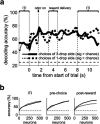Orbitofrontal State Representations Are Related to Choice Adaptations and Reward Predictions
- PMID: 33446521
- PMCID: PMC7939081
- DOI: 10.1523/JNEUROSCI.0753-20.2020
Orbitofrontal State Representations Are Related to Choice Adaptations and Reward Predictions
Abstract
Animals can categorize the environment into "states," defined by unique sets of available action-outcome contingencies in different contexts. Doing so helps them choose appropriate actions and make accurate outcome predictions when in each given state. State maps have been hypothesized to be held in the orbitofrontal cortex (OFC), an area implicated in decision-making and encoding information about outcome predictions. Here we recorded neural activity in OFC in 6 male rats to test state representations. Rats were trained on an odor-guided choice task consisting of five trial blocks containing distinct sets of action-outcome contingencies, constituting states, with unsignaled transitions between them. OFC neural ensembles were analyzed using decoding algorithms. Results indicate that the vast majority of OFC neurons contributed to representations of the current state at any point in time, independent of odor cues and reward delivery, even at the level of individual neurons. Across state transitions, these representations gradually integrated evidence for the new state; the rate at which this integration happened in the prechoice part of the trial was related to how quickly the rats' choices adapted to the new state. Finally, OFC representations of outcome predictions, often thought to be the primary function of OFC, were dependent on the accuracy of OFC state representations.SIGNIFICANCE STATEMENT A prominent hypothesis proposes that orbitofrontal cortex (OFC) tracks current location in a "cognitive map" of state space. Here we tested this idea in detail by analyzing neural activity recorded in OFC of rats performing a task consisting of a series of states, each defined by a set of available action-outcome contingencies. Results show that most OFC neurons contribute to state representations and that these representations are related to the rats' decision-making and OFC reward predictions. These findings suggest new interpretations of emotional dysregulation in pathologies, such as addiction, which have long been known to be related to OFC dysfunction.
Keywords: cognitive map; odor; orbitofrontal; rat; single unit.
Copyright © 2021 the authors.
Figures







Similar articles
-
Orbitofrontal Cortex Signals Expected Outcomes with Predictive Codes When Stable Contingencies Promote the Integration of Reward History.J Neurosci. 2017 Feb 22;37(8):2010-2021. doi: 10.1523/JNEUROSCI.2951-16.2016. Epub 2017 Jan 23. J Neurosci. 2017. PMID: 28115481 Free PMC article.
-
Identity-Specific Reward Representations in Orbitofrontal Cortex Are Modulated by Selective Devaluation.J Neurosci. 2017 Mar 8;37(10):2627-2638. doi: 10.1523/JNEUROSCI.3473-16.2017. Epub 2017 Feb 3. J Neurosci. 2017. PMID: 28159906 Free PMC article.
-
The orbitofrontal cortex as part of a hierarchical neural system mediating choice between two good options.J Neurosci. 2013 Oct 2;33(40):15989-98. doi: 10.1523/JNEUROSCI.0026-13.2013. J Neurosci. 2013. PMID: 24089503 Free PMC article.
-
Taking stock of value in the orbitofrontal cortex.Nat Rev Neurosci. 2022 Jul;23(7):428-438. doi: 10.1038/s41583-022-00589-2. Epub 2022 Apr 25. Nat Rev Neurosci. 2022. PMID: 35468999 Free PMC article. Review.
-
Linking dynamic patterns of neural activity in orbitofrontal cortex with decision making.Curr Opin Neurobiol. 2018 Apr;49:24-32. doi: 10.1016/j.conb.2017.11.002. Epub 2018 Jan 9. Curr Opin Neurobiol. 2018. PMID: 29169086 Free PMC article. Review.
Cited by
-
Diminished State Space Theory of Human Aging.Perspect Psychol Sci. 2025 Mar;20(2):325-339. doi: 10.1177/17456916231204811. Epub 2023 Nov 6. Perspect Psychol Sci. 2025. PMID: 37931229 Free PMC article.
-
The medial and lateral orbitofrontal cortex jointly represent the cognitive map of task space.Commun Biol. 2025 Feb 3;8(1):163. doi: 10.1038/s42003-025-07588-w. Commun Biol. 2025. PMID: 39900714 Free PMC article.
-
The Role of a Dopamine-Dependent Limbic-Motor Network in Sensory Motor Processing in Parkinson Disease.J Cogn Neurosci. 2023 Nov 1;35(11):1806-1822. doi: 10.1162/jocn_a_02048. J Cogn Neurosci. 2023. PMID: 37677065 Free PMC article.
-
Lateral Orbitofrontal Cortex Encodes Presence of Risk and Subjective Risk Preference During Decision-Making.bioRxiv [Preprint]. 2024 Apr 9:2024.04.08.588332. doi: 10.1101/2024.04.08.588332. bioRxiv. 2024. Update in: Cereb Cortex. 2025 Jun 4;35(6):bhaf146. doi: 10.1093/cercor/bhaf146. PMID: 38645204 Free PMC article. Updated. Preprint.
-
Differential coding of goals and actions in ventral and dorsal corticostriatal circuits during goal-directed behavior.Cell Rep. 2022 Jan 4;38(1):110198. doi: 10.1016/j.celrep.2021.110198. Cell Rep. 2022. PMID: 34986350 Free PMC article.
References
Publication types
MeSH terms
Grants and funding
LinkOut - more resources
Full Text Sources
Other Literature Sources
